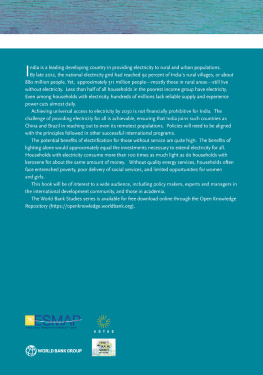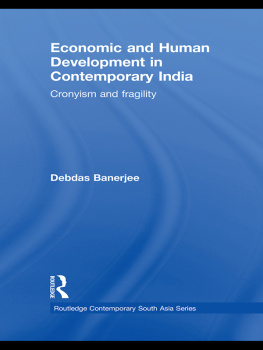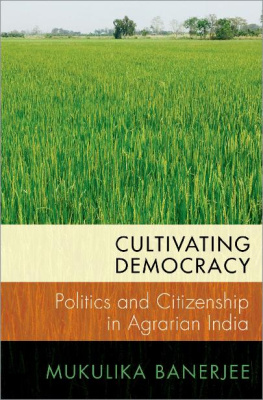A WORLD BANK STUDY
Power for All
Electricity Access Challenge in India
Sudeshna Ghosh Banerjee, Douglas Barnes, Bipul Singh, Kristy Mayer, and Hussain Samad

2015 International Bank for Reconstruction and Development / The World Bank
1818 H Street NW, Washington DC 20433
Telephone: 202-473-1000; Internet: www.worldbank.org
Some rights reserved
1 2 3 4 17 16 15 14
World Bank Studies are published to communicate the results of the Banks work to the development community with the least possible delay. The manuscript of this paper therefore has not been prepared in accordance with the procedures appropriate to formally edited texts.
This work is a product of the staff of The World Bank with external contributions. The findings, interpretations, and conclusions expressed in this work do not necessarily reflect the views of The World Bank, its Board of Executive Directors, or the governments they represent. The World Bank does not guarantee the accuracy of the data included in this work. The boundaries, colors, denominations, and other information shown on any map in this work do not imply any judgment on the part of The World Bank concerning the legal status of any territory or the endorsement or acceptance of such boundaries.
Nothing herein shall constitute or be considered to be a limitation upon or waiver of the privileges and immunities of The World Bank, all of which are specifically reserved.
Rights and Permissions

This work is available under the Creative Commons Attribution 3.0 IGO license (CC BY 3.0 IGO) http://creativecommons.org/licenses/by/3.0/igo. Under the Creative Commons Attribution license, you are free to copy, distribute, transmit, and adapt this work, including for commercial purposes, under the following conditions:
AttributionPlease cite the work as follows: Banerjee, Sudeshna Ghosh, Douglas Barnes, Bipul Singh, Kristy Mayer, and Hussain Samad. 2015. Power for All: Electricity Access Challenge in India. World Bank Studies. Washington, DC: World Bank. doi: 10.1596/978-1-4648-0341-3. License: Creative Commons Attribution CC BY 3.0 IGO
TranslationsIf you create a translation of this work, please add the following disclaimer along with the attribution: This translation was not created by The World Bank and should not be considered an official World Bank translation. The World Bank shall not be liable for any content or error in this translation.
AdaptationsIf you create an adaptation of this work, please add the following disclaimer along with the attribution: This is an adaptation of an original work by The World Bank. Views and opinions expressed in the adaptation are the sole responsibility of the author or authors of the adaptation and are not endorsed by The World Bank.
Third-party contentThe World Bank does not necessarily own each component of the content contained within the work. The World Bank therefore does not warrant that the use of any third-party-owned individual component or part contained in the work will not infringe on the rights of those third parties. The risk of claims resulting from such infringement rests solely with you. If you wish to reuse a component of the work, it is your responsibility to determine whether permission is needed for that re-use and to obtain permission from the copyright owner. Examples of components can include, but are not limited to, tables, figures, or images.
All queries on rights and licenses should be addressed to the Publishing and Knowledge Division, The World Bank, 1818 H Street NW, Washington, DC 20433, USA; fax: 202-522-2625; e-mail: .
ISBN (paper): 978-1-4648-0341-3
ISBN (electronic): 978-1-4648-0345-1
DOI: 10.1596/978-1-4648-0341-3
Cover photo: NOAA. This photograph is in the public domain and available for public use. Please credit NOAA.
Cover design: Debra Naylor, Naylor Design, Inc. / Bill Pragluski, Critical Stages, LLC.
Library of Congress Cataloging-in-Publication Data has been requested.
Contents
Foreword |
Acknowledgments |
Abbreviations |
Executive Summary |
Status of Electrification Progress: Access and Reliability |
Historical Progress in Providing Energy Access |
Policy Recommendations for Moving Forward |
Chapter 1 | Introduction |
Abstract |
Commitment to Universal Access |
Benefits of Electrification |
Study Goal and Organization of This Report |
Notes |
Chapter 2 | Closing the Electricity Access Gap |
Abstract |
Recent Growth Trends |
Current Profile of Electricity Deficit |
Estimated Benefits of Universal Access |
Summary Remarks |
Notes |
Chapter 3 | Barriers to Household Adoption |
Abstract |
The Gap between Electricity Access and Adoption |
Impact of Power Reliability on Electricity Adoption |
Household Affordability |
Summary Remarks |
Note |
Chapter 4 | History of Rural Electrification and Institutional Organization |
Abstract |
Evolution of Rural Electrification |
Institutional Organization |
National Policies and the RGGVY Program |
Summary Remarks |
Notes |
Chapter 5 | Challenges to Sustaining Progress |
Abstract |
Near-Term Financing and Implementation Challenges |
Long-Term Risks to Sustainability |
Summary Remarks |
Notes |
Chapter 6 | Lessons from International Experience |
Abstract |
Institutional Focus on Integrating Grid and Off-Grid Efforts |
Planning and Load Development |
Utility Cost Recovery and Supply Reliability |
Lower Barriers to Adoption |
Community Involvement and Service Orientation |
Lower Construction and Operation Costs |
Moving Forward |
Notes |
Appendix A | Estimating Investment Needs for Universal Access |
Appendix B | Household Survey Data Description: National Sample Survey Organization |
Appendix C | Data Tables |
Next page













